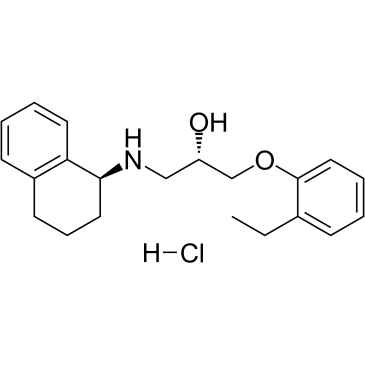| Cas No.: | 1135278-41-9 |
| Chemical Name: | 1-(2-Ethylphenoxy)-3-[[(1S)-1,2,3,4-tetrahydro-1-naphthalenyl]amino]-(2S)-2-propanol hydrochloride |
| Synonyms: | SR 59230A HCl; SR59230A HCl; SR 59230A; SR59230A; SR-59230A. |
| SMILES: | CCC1=CC=CC=C1OC[C@H](CN[C@H]2CCCC3=CC=CC=C23)O.Cl |
| Formula: | C21H28ClNO2 |
| M.Wt: | 361.91 |
| Purity: | >98% |
| Sotrage: | 2 years -20°C Powder, 2 weeks 4°C in DMSO, 6 months -80°C in DMSO |
| Description: | SR59230A hydrochloride is a potent, selective, and blood-brain barrier penetrating β3-adrenergic receptor antagonist[1] with IC50s of 40, 408, and 648 nM for β3, β1, and β2 receptors, respectively[2]. |
| Target: | IC50: 40 nM (β3 receptor), 408 nM ((β1 receptor), 648 nM (β2 receptor)[2] |
| In Vivo: | MDMA (20 mg/kg) produces a slowly developing hyperthermia, reaching a maximum increase of 1.8°C at 130 min post injection. SR59230A (0.5 mg/kg) produces a small but significant attenuation of the slowly developing hyperthermia to MDMA. SR59230A (5 mg/kg) reveals a significant and marked early hypothermic reaction to MDMA[4]. Animal Model: Male C-57BL6J wild-type mice (22-35 g)[4] Dosage: 0.5 or 5 mg/kg Administration: Injected s.c.; administered 30 min prior to the injection s.c. of MDMA (20 mg/kg). Result: Modulated the actions of MDMA on temperature involve α1-adrenoceptor antagonism. |
| In Vitro: | SR59230A (100 nM-50 μM; 24 hours) is able to reduce cell viability in a dose-dependent manner in Neuro-2A, BE(2)C and SK-N-BE(2) NB cell lines[3]. Cell Viability Assay[3] Cell Line: Three different neuroblastoma (NB) cell lines, one murine (Neuro-2A) and two human (SK-N-BE(2), BE(2)C) Concentration: 100 nM, 1 μM, 5 μM, 10 μM, and 50 μM Incubation Time: 24 hours Result: Reduced cell viability in a dose-dependent manner, with significant effect at a concentration limit over 1 µM for Neuro-2A cells and 5 µM for SK-N-BE(2) and BE(2)C). |
| References: | [1]. Nisoli E, et al. Functional studies of the first selective beta 3-adrenergic receptor antagonist SR 59230A in rat brown adipocytes.Mol Pharmacol. 1996 Jan;49(1):7-14. [2]. Kanzler SA, et al. Involvement of β3-adrenergic receptors in the control of food intake in rats.Braz J Med Biol Res. 2011 Nov;44(11):1141-7. [3]. Bruno G, et al. β3-adrenoreceptor blockade reduces tumor growth and increases neuronal differentiation in neuroblastoma via SK2/S1P2 modulation.Oncogene. 2020 Jan;39(2):368-384. [4]. Bexis S, et al. Role of alpha 1- and beta 3-adrenoceptors in the modulation by SR59230A of the effects of MDMA on body temperature in the mouse. Br J Pharmacol. 2009 Sep;158(1):259-66. |

 To enhance service speed and avoid tariff delays, we've opened a US warehouse. All US orders ship directly from our US facility.
To enhance service speed and avoid tariff delays, we've opened a US warehouse. All US orders ship directly from our US facility.





















